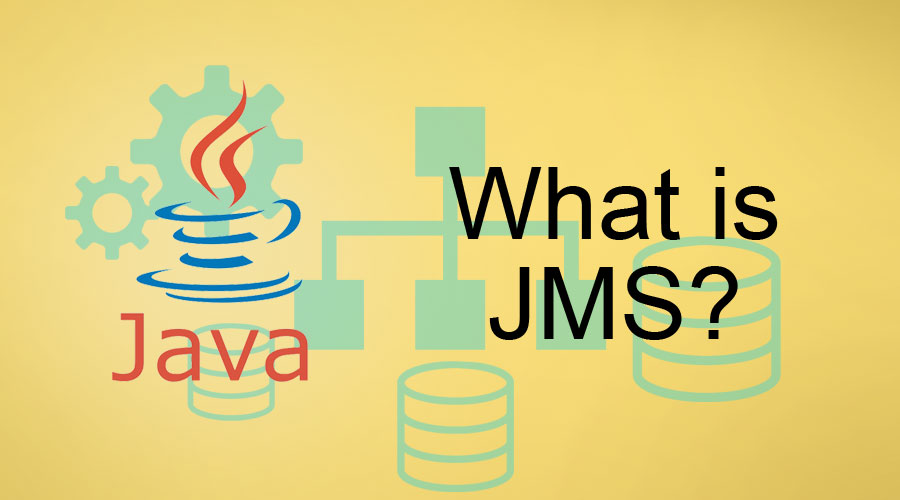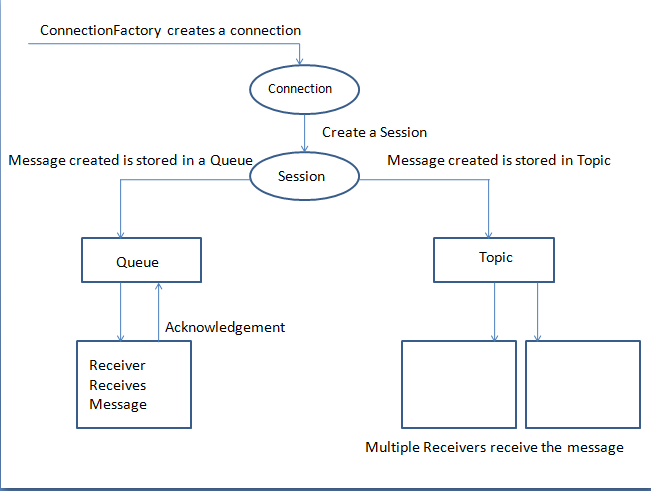Updated March 13, 2023

Introduction to JMS
It stands for Java Messaging Services, which is used for establishing a network of successful communication amongst multiple units and applications inside a particular system. Typically, it is in the form of an application program interface that passes messages from one application program to another, with the help of a queue path. It is well-known for its qualities like automated message communication, lesser or no constraints for carrying out the activities, an in-built interface with a common messaging protocol.
Understanding
- It is an API that sends messages from one application to another application.
- Suppose one application server is in India and another application is in some other country, then it helps in creating a message and send it from the host application to the receiver application that receives the message.
- It consists of a Queue where it creates a message from one application, and the message will be in Queue until the receiver application receives the message.
How does it make working so easy?
- It introduces Messaging, a form of communication that requires an intermediate to perform the communication between two applications that are not coordinated with each other.
- Both the sender and receiver do not need to be present at the same time for communicating the message. That makes communication easier it.
What can you do with JMS?
It minimizes the constraints present in sending a message.
It provides a way of automation, as programmers are not required to know the set of concepts required for messaging process.
It provides an interface for common protocols and other messaging services.
A message can be delivered using it in two ways:
1. Point to Point:
- This is a method of communication where the sender (one who creates and sends the message) can send the message to only one receiver (one who receives the message) at a time.
- This method uses a Queue mechanism where the message will be sent to a Queue, a destination point. The Sender sends the message to the destination, and the receiver from the destination can consume the message.
- It is important that the receiver is registered to the destination, or else the receiver cannot consume the message.
- If no receiver is registered to the destination, then the message will be in a destination until any receiver registers with the destination to receive it.
- Any no of senders can send the message, but one receiver can consume the message.
2. Publish/Subscribe:
- This method of communication allows a sender to communicate the message to many receivers.
- Unlike Queue, it uses Topic as a destination point.
- So in this method, all the consumers must subscribe to the destination point.
- Once the message is sent from the sender to the destination point, all the active receivers who are subscribed to the Topic can consume the message.
- Unlike Queue, Topic destination point cannot hold messages unless for a subscribed consumer who was inactive at the time of delivery of the message.
- This kind of subscription is known as a Durable Subscription.
Working
The application architecture consists of the following components:
JMS Provider
- It delivers control and administrative features and implements the necessary interface for message transfer.
JMS Clients
- They are the Sender and Receiver, which uses JMS to send and consume messages.
- They are written in the Java programming language.
Administered Objects
- They consist of the Destination points (Queue and Topic) and the connection factories.
- They are preconfigured and are also known as JMS objects.
Messages
- The final component or part is the actual message that communicates the necessary information.
Advantages
It has the following advantages
- It has a greater throughput as a result of efficient Load Balancing
- The ability to make communication possible between two applications that have different Message Providers.
- This is very easy and Reliable.
- It has a very clear, definite, and simple API that enables programmers to get hold of the architecture and create messages and enable the communication network.
- It is very versatile. In JMS, messages can be sent either by point to point or broadcasted to several receivers. The main part is that it is also efficient enough to combine both the methods and transfer messages as and when the need arises.
- The communication between components is loosely coupled.
- The message will be deleted from the Queue only when the message is received and acknowledged by the receiver.
- It has an asynchronous Message Queue.
- Due to being asynchronous, the messages will be sent more often than not faster than the time specified, thus enabling many messages to be created and sent again through the network resulting in greater efficiency.
- Due to its easy architecture, it is widely supported and accepted by every industry that it has been implemented for Message transfer service for Java applications.
Required Skills
- To understand JMS.
- Understanding of Java is a must.
- Knowledge of a Java Framework is necessary.
- Basic understanding of the Connection Transfer concept.
- Architectural understanding of it is essential
Why should we use it?
JMS Connection: The ConnectionFactory object creates a connection which is established by implementing a connection interface for the transfer of messages.
To create a connection,
Once the connection is established, it is imperative that we create the destination point depending upon which type of message transfer we intend to execute using it.
To create a Queue session,
To create a Topic Session,
After that, we need to create the Queue Receiver or the Topic subscriber and call it through the destination point object.
Once the process is done, close the connection.
Scope
- In JMS, Scope is nothing but the specification of the resource availability level.
- The Scope can be set by changing the configuration properties of the JMS provider.
- Through the administrative console, go to Resources -> JMS -> JMS providers.
- Here you can set the Scope set to the desired level.q
As a job, it is very much essential if you want to make it as a successful Java developer with good infrastructure knowledge of the system.
Why do we need it?
We need JMS for the following.
- Easy scalability of applications.
- Easy communication of applications written in Java.
- Time consumption in creating a set of code and understanding messaging service algorithms to create a connection.
Who is the Right Audience for Learning JMS Technologies?
Anyone experienced in Java Application Development and Management of several Java Application Data.
How will this Technology help you in Career growth?
Career growth will be great as you will learn in deep the system requirements and the java application interface features, giving you an easy path for an extraordinary Java Application Developer and even beyond as a Project or Delivery Manager as you get to manage several java applications where it will come into play.
Conclusion
It has been accepted industry-wide by experts in the Information Technology Industry. It will continue to grow, and hence learning it will help you adapt to the growing demands of the industry and help you in being updated in java and aid you in a longer and greater career.
Recommended Articles
This has been a guide to What is JMS?. Here we discussed the basic concept, skills required, working, need, along with career growth and advantages of JMS. You can also go through our other suggested articles to learn more –

